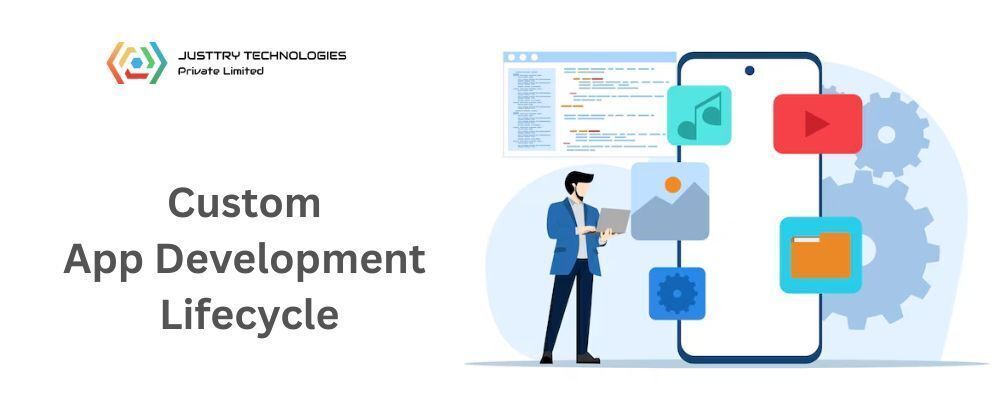1. Introduction
In today’s fast-paced digital world, creating a generic solution just won’t cut it. That’s why custom app development is more than just a buzzword—it's a necessity. Whether it's mobile or web, businesses want applications tailored exactly to their processes, goals, and users.
Why Custom Apps Matter in the Digital Age
With every industry going digital, off-the-shelf apps often fall short. Businesses need something specific—like a perfectly tailored suit. Custom apps fill that gap by providing solutions designed for a particular audience or task.
The Rise of Tailored Solutions
From small startups to large enterprises, custom-built applications help solve unique challenges and offer a significant edge over the competition. And with the rise of mobile devices, mobile app development has become a critical part of this ecosystem.
2. Stage 1 – Idea & Requirements Gathering
Understanding Business Needs
Every great app begins with a solid understanding of the business it serves. This stage involves sitting down with stakeholders to uncover pain points, goals, and expectations.
Defining Core Objectives and Features
Here, you translate problems into features. What must the app do? What features are essential? What’s just "nice to have"? Clarity here sets the tone for the rest of the project.
3. Stage 2 – Planning & Strategy
Market Research and User Persona Development
You can't build a useful app without knowing your users. Understanding who they are, what they need, and how they behave shapes your entire development strategy.
Choosing the Right Tech Stack
Depending on the app’s purpose, your team will select technologies that ensure scalability, performance, and security. Choices here affect everything—from cost to future upgrades.
4. Stage 3 – Design Phase
UX vs. UI – What’s the Difference?
User Experience (UX) is how it works; User Interface (UI) is how it looks. Together, they make your app intuitive and visually appealing. Get these wrong, and users will bounce.
Wireframes and Prototypes
Before writing a single line of code, your team will create sketches and mockups. These act as blueprints and give you a glimpse of how the app will behave.
5. Stage 4 – Development Process
Frontend vs Backend Development
Frontend: What users see and interact with.
Backend: Servers, databases, and APIs that power it.
Both must work together seamlessly to create a smooth experience.
Agile vs Waterfall Methodologies
Agile is iterative. Waterfall is linear. For most custom application development companies, Agile is the go-to.
Why Agile Is Often Preferred
It allows frequent feedback, quick adjustments, and continuous improvement—perfect for apps evolving with time.
6. Stage 5 – Testing & Quality Assurance
Manual and Automated Testing
Bugs are inevitable—but finding and fixing them early prevents disasters later. Both manual and automated testing are crucial here.
Common Bugs and How They’re Caught Early
Issues like broken links, slow performance, or UI glitches are tackled during testing. QA ensures the app works flawlessly before launch.
7. Stage 6 – Deployment
Preparing for Launch
This involves final reviews, server setup, and ensuring compatibility with different devices and platforms.
App Store Optimization (ASO)
Think SEO but for apps. Optimizing titles, keywords, and screenshots helps your app rank higher in stores like Google Play or Apple App Store.
8. Stage 7 – Post-Launch Support & Maintenance
Handling Bugs After Release
Even with rigorous testing, some issues only show up in the wild. A responsive dev team should be ready to patch things up fast.
Planning for Future Updates
Your app isn’t a one-and-done. Plan for feedback-driven updates, new features, and adapting to market changes.
9. Choosing the Right Development Partner
What to Look for in a Software Development Company
Experience, portfolio, client reviews, and communication skills are key. Look for a partner, not just a provider.
Questions to Ask Before Signing a Contract
What’s your development process?
How do you handle changes?
Will I own the code?
These can make or break your experience.
10. Key Benefits of Custom App Creation
Competitive Advantage
Tailored apps let you do things your competitors can’t. From unique features to branding—custom wins every time.
Scalability and Flexibility
As your business grows, your app grows with it. Off-the-shelf solutions? Not so much.
11. Mistakes to Avoid in Custom Application Development
Ignoring User Feedback
Building for users means listening to them. Skipping feedback is like cooking without tasting.
Skipping MVP (Minimum Viable Product)
Launching with a core feature set lets you test the waters, save costs, and pivot if needed. Don’t aim for perfection right away.
12. The Role of a Custom Software Company in Your Success
Ongoing Collaboration & Communication
Good partners don’t disappear after launch. A great custom software company stays in touch, helps you scale, and fixes issues quickly.
Technical Support and Scaling Strategy
From integrating APIs to handling surges in traffic, your development team should be ready to adapt as you grow.
13. Trends in Mobile Application Development
AI, IoT, and Cloud Integrations
New tech is shaping how we build apps. Smart integrations make apps more powerful and responsive
.
Cross-Platform vs Native Development
Want speed and reach? Go cross-platform. Want performance and depth? Native might be the way. Either way, tech evolves fast—stay informed.
14. Final Thoughts
Custom app development isn’t just about code—it’s a journey of understanding users, solving problems, and building something valuable. With the right strategy and team, you can turn ideas into digital realities. So, are you ready to bring your custom app vision to life?




Top comments (0)